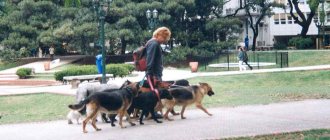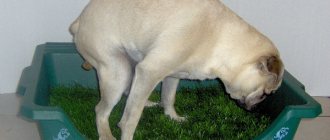Reasons for “escape” while walking
If you are interested in a long-term solution to the problem, that is, teaching your dog not to run away and calmly let your pet off the leash, it is important to find out and eliminate the reasons for “running” during a walk.
In most cases, if a dog starts to run away, the owner decides that it cannot be subdued and puts up with this annoying factor.
Breed characteristics
Huskies, Malamutes and other northern dogs. Representatives of such breeds are hyperactive, and their genetics have a desire to run. Practice shows that even well-trained northern dogs often run away from their owners, especially if they do not receive sufficient physical exercise. It is better to walk them for life on a long, loose leash. You can only let your dog off the leash in fenced areas.
Laikas, greyhounds and other hound-type dogs. Representatives of such breeds tend to chase prey if they smell it. It is important to understand that when a dog smells prey, its attention and behavior are completely “managed” by the hunting instinct. The dog takes off and starts running, does not hear commands, does not pay attention to stimuli. To prevent escapes, the dog needs to be actively walked every day. In addition, you need to train your pet long and hard, reinforcing the execution of the call. To “compete with instincts” when teaching calling, it is better to use a whistle.
Dachshunds, Jack Russell Terriers and other burrowing dogs. Representatives of the breed are hyperactive and require very serious daily stress. If there is insufficient load, dogs regularly run away and can rarely find their way home on their own.
Beagles, Setters, Shorthaired Pointers and other gun breeds. The reasons for escapes and methods for correcting the situation are similar to those written above. However, there is a consoling point - gun dogs learn easier and faster.
The dog runs home
Most likely, the pet feels insecure or suffers from illness. The desire to quickly finish a walk is inherent in melancholic and elderly dogs.
A dog may run home if it is cold or uncomfortable. For example, short-haired dogs often try to return home quickly from a winter walk. In all other cases, the problem is solved by changing the approach to organizing the walk.
Escape to other dogs
If your pet runs to other dogs, then your ward lacks physical activity and socialization. Animals that live in a private home and rarely go out into the world are prone to escapes of this type. Lack of socialization has a detrimental effect on the psyche and health of the dog as a whole.
What to do if the dog tries to run away
Fix flaws in the fence. If the “mole” has learned to dig tunnels, they make a trench under the fence and dig in large stones, a curb, or pour a narrow strip foundation about 30 cm deep without formwork. The chain-link mesh is lowered and dug into the ground. The lower edge is fixed in the ground in any convenient way. Often dogs jump over the fence if, for example, there is a booth or firewood stacked under the fence. In this case, you can try to remove the improvised step. It is more difficult if the “athlete” overcomes the fence from the ground. Here you need to either increase its height or build a “bumper”. A small canopy on the inside of the fence. It doesn't have to be solid. It is enough to place an obstacle in the form of a wooden block or a metal corner at a short distance from the top edge of the fence.
Example of a fence with a corner at the top
There is no point in experimenting with barbed wire. A dog will still jump and may get hurt, but a very persistent dog will not analyze and learn from its mistakes. If the dog has learned to open the gate itself, installing a small latch or hook will help. Abroad, where two-meter fences are not in fashion, dog breeders actively use electronic fencing. It consists of posts with sensors and an electric shock collar. In an attempt to run outside the perimeter, the dog receives a nasty electric shock.
Eliminating the possibility of escape is the main task. Of course, you can put an animal on a chain or lock it in an enclosure, but will a “life sentence” be fair to a faithful friend?
It is difficult to say how to stop a dog from running away, but you can do everything possible to prevent it from wanting to do so. Therefore, the next step should be to eliminate the cause of escapes and organize leisure time:
- Castration or sterilization will solve the problem of love sprees;
- You need to spend more time with the dog, take it for walks outside the yard, and be sure to play active games in the yard. Provide the opportunity to communicate with relatives. Walked and tired, she will be less eager to cross the fence;
- Provide leisure time while the owners are away. The dog is given toys that you can make yourself. Before leaving, you can hide them around the yard in different places. Somewhere, instead of a toy, you can put a treat. First, they play “search” with the dog. Having mastered the rules of the game, in the absence of the owner the animal will periodically check the places where the “treasures” were previously located.
- Praise cannot be punished. In this sentence, it is important to place a comma after the word “praise.” An attempt to escape should not be stopped with punishment, only with a treat or a game. And even more so, scold for returning, causing negative associations associated with home.
A collar with a GPS tracker will help you find a fugitive
Simple rules of behavior when walking with a dog
Simple rules of behavior when walking a dog will help prevent your pet from escaping and ensure its safety during training.
Collar and leash. Until you are sure that your pet is under control, walk it only on a leash. If there are no contraindications, you should use a collar rather than a harness, as it creates more discomfort and allows you to better control your pet. Do not walk your dog on a tape measure; it is better to use a 7–10 meter canvas leash.
Clear statement of the task. For the entire training period, you must focus on only one goal and constantly demonstrate to your pet that you are in control. This rule applies not only to calling, but also to submission in general. If the dog does not respond to your commands and runs away, it believes that such behavior is permissible, and only you are to blame for this.
Note! A dog that respects its owner will not dare to disobey his orders.
Active walking and socialization. The only time you can let your dog off the leash is when playing and walking in the company of other trained four-legged animals. When a dog walks in a pack, it obeys the general rules of behavior. There is a risk of escape, but it is minimal if other dogs listen to their owners and return to them when called.
Identification in case of escape. If your pet is prone to running away, it is wiser to take steps to reduce the risks in advance. It is easier to find a runaway dog if there are identifiers on the collar:
- Address capsule or token.
- GPS sensor for tracking.
Subsequence. Perhaps this is the most important nuance in training a dog to return to its owner.
Many owners make the same mistake: the dog runs away and does not obey, the owner gives the command “Come to me” several times, the dog runs for a while, but then comes up to the owner. What happens next? The owner begins to swear. What conclusions does the dog make? Next time, it's better not to come back at all.
If the dog runs away from home
In certain circumstances, a dog can easily run away from home. The most common reasons for running away:
- long absence of the owner;
- the presence of an open window, a balcony on the lower floors of the apartment;
- congenital or acquired fearfulness of the pet;
- sharp sounds outside the house;
- the presence of extraneous irritants - odors, animals running nearby, distracting passers-by.
If the dog is in foster care or has a previous owner, the animal may try to run away to find its previous home. If you are adopting an adult pet, it is important to build a good relationship and walk it well. Basic ways to prevent running away from home:
- securely close windows and front doors;
- ensure good physical activity, quality walking of the pet;
- leave a treat so that the animal has something to do;
- if a thunderstorm or fireworks explosions are planned (for the New Year), it is recommended to lock the animal in a small room without windows.
Treats can be hidden around the apartment to keep your pet interested while you are away. Various bones are effective, requiring a lot of time to crack them. After your return, your four-legged friend should always be rewarded for good behavior. Being alone should be taken calmly; the dog must be accustomed to this from puppyhood - left alone in the house, gradually increasing the duration.
How to properly punish a dog for disobedience
The main point of punishment is that the dog must understand its mistake, and not conclude that next time it is better not to carry out the command.
A dog should not be punished:
- Physically - if in other aspects of education one can argue, then physical punishment for failure to comply with the call is one of the most serious mistakes.
- Threatening with a leash - the equipment should be perceived exclusively positively with the dog.
- After the dog itself has approached you.
Punishment for disobedience is only acceptable if you had to chase your pet.
Reproductive instinct
There is a chance that your pet is running away from the backyard in search of a dog of the opposite sex. After the animal is six months old, its reproductive instincts begin to turn on. Male dogs are more likely to leave the house as soon as they smell a female.
After the long holidays, I prepare zucchini, chickpea and pea soup for the whole family.
Where they throw ice cream, where they pour water on them: New Year's traditions of different nations
Burns from pyrotechnics: the doctor spoke about the most common injuries in the New Year
In what cases will you need professional help?
In what cases will you need professional help:
- You are raising your first dog on your own and not seeing results for 2-4 weeks.
- A runaway dog is prone to aggression towards other animals or people.
- The dog runs away due to breed characteristics.
- Having run away, the pet does not pay attention to traffic and runs across the roads.
- A pet may chase a cat or other animal without paying attention to its surroundings.
Reason for running away
It happens that an animal runs away, frightened by a car horn, the noise of a construction site, bright flashes of light, or strangers passing by the fence.
Having understood the reason for the dog’s fear, follow a number of rules:
- Try to eliminate the causes of fear.
- If elimination is not possible, limit the cause of exposure to the animal. For example, take it into the house during periods of strong noise.
- Try to understand where the dog hides when very frightened. Create a “shelter” at home that reminds the animal of this place in appearance.
- Try to “desensitize” your pet - teach it not to be afraid of frightening phenomena. Start accustoming to small “doses” of the stimulus by being nearby and calming the animal. Little by little, teach your pet to calmly react to frightening phenomena.
- Fearing separation, the pet runs away, trying to find its owner. Make leaving and returning unnoticeable, letting the dog know that nothing bad will happen, the owner will definitely return.
If the dog is too restless and suspicious, give special sedatives prescribed by a veterinarian.
How to catch a runaway dog
A breathtaking sight - the owner runs after the dog, which dodges in every possible way and does not allow itself to be caught. Before setting off in pursuit, it is necessary to analyze whether this is what the pet is trying to achieve?
Dogs do not specifically approach their owner for the following reasons:
- Lack of Attention - When you chase a dog, you are giving him attention, at least that's how he perceives it. Lack of physical activity - for a dog, the process of chasing is just physical exercise.
- Lack of intellectual tasks - the dog perceives the chase as a game.
In all the above cases, the same picture will be observed. The dog will run fast enough to keep you on its tail. This behavior is not escape - it is manipulation. A truly running dog is capable of a well-prepared person.
If a pet takes off and runs without looking back, it is useless to catch up with it. The best thing you can do is stay put. The reason is that the ward, sooner or later, will come to his senses and realize that he ran away. The first thing he does (if he can) is to return to the place from which he escaped.
Tip: if you've waited too long and it's time to sound the alarm, leave a leash or other personal item in the place where the dog ran away.
How to train a dog so that it does not run away and always stays in the yard
Many people are faced with the problem that the dog does not stay in the backyard, but constantly runs away somewhere. There are certain reasons for this. Almost every dog enjoys running around in new places. However, when an animal constantly runs away from home, it becomes a bit of a challenge.
The task of every owner is to maintain the health of their four-legged friend. So how do you train your dog to stay in the yard?
Training techniques should be explored to ensure your dog remains safe at all times.
First you need to find out why the dog does not want to stay in the backyard.
First you need to determine whether the animal is doing this out of its own fear. Perhaps something is frightening the dog, so it is trying to hide. In addition, animals often react too strongly to unfamiliar noises. Perhaps there is construction work going on in a neighboring area and your pet is simply scared. He may also be afraid of various visual images, such as flashes of bright lights or strangers walking on the sidewalk past your house.
How to find a dog if it's completely lost
How to find a dog if it is completely lost:
- Ask friends and acquaintances for help.
- Call all dog owners you know and tell them that your pet has escaped.
- Print out paper advertisements as quickly as possible and place them in prominent places (poles, bus stops, entrances, walking areas, parks) in your area of residence.
- Disseminate information about the loss of a dog on social networks, on trading platforms and all available Internet resources.
- Promise a reward for the dog's return.
- Regularly comb the area and return to the escape site.
- Leave a bowl of water and food at the escape site; many dogs do not immediately manage to retrace their steps.
- Constantly expand your search area.
The search process is greatly simplified if the dog has identifiers on its collar. This way, people who find your dog will be able to contact you as quickly as possible.
What makes a dog run away from home?
Any dog, even the most educated and trained one, will run away or at least leave the yard if given the opportunity. Another question is how quickly will it return and will it come back at all? It all depends on the reasons that force the four-legged friend to leave his native abode.
Take precautions against your dog escaping in advance
Males can overcome imaginable and inconceivable obstacles by sensing a flowing bitch. Not least of all is the tendency to wander. In principle, any breed of dog can become a runaway, but sled dogs and hunting dogs are more susceptible to this due to their innate desire to pursue. Vagrancy is more typical of shepherd breeds and mongrel dogs. More often it is associated with a lack of work, social connections and new information. Guard breeds have a very strong sense of territoriality, so they rarely run away.










